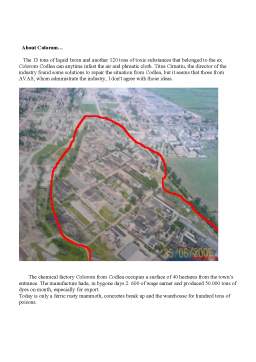Extras din proiect
About pollution
Every day we pour or release harmful substances such as poisonous gases, chemicals and garbage into our environment. These harmful substances that end up damaging the environment, are called pollution.
Most pollution comes from factories and transportation but as you will see we all contribute to it in many different ways.
There is air pollution, water pollution, soil pollution and even noise pollution.
As you will see, if not handled properly, pollution can and has contaminated our air, water and land.
Air Pollution
Every living creature relies on clean air to survive. Air is made up of a mixture of gases, mainly oxygen and nitrogen, with small amounts of carbon dioxide plus water. Air has no colour or smell, except when it is polluted. Dirty air can affect the health of humans, animals, plants and can even damage buildings. Industry and transportation produce most of the air pollution, releasing millions of tons of harmful substances into the environment each year
The burning of fossil fuels (coal and oil) is the source of or generates most of the world's energy. Unfortunately it also generates most of the world's air pollution. That is because when we burn the fossil fuels to produce energy we end up releasing waste in the form of toxic gases. Carbon monoxide, carbon dioxide, nitrogen oxides and sulphur dioxides are some of the most dangerous gases produced during the burning of fossil fuels.
Carbon dioxide gases play a big role in the greenhouse effect by trapping heat rather than allowing it to escape into space. It is not just what is released into the air that causes problems; it is also how individual pollutants interact with each other, water and/or sunlight. For example, sulphur dioxide and nitrogen oxide are both dangerous when they combine with other substances to create problems such as smog and acid rain.
Gases are not the only air pollutants that we should be concerned about. Tiny bits of dust, metal, soot and other materials also find their way into the atmosphere from manufacturing plants, construction sites, wood burning stoves and cars. These small particles reduce the quality of the air that we breathe.
Also, sometimes rain contains chemicals called acids that can harm the environment including plants and animals living on land and in the water, as well as damage buildings and other manmade structures such as monuments, roads and vehicles. Acids cause so much harm because they can burn into materials. Acid rain forms when sulphur dioxide and nitrogen dioxide (produced by burning fuels) are released into the air. These two gases mix with water to form a weak acid which falls as rain. The gases that cause acid rain are released by power plants, factories and transportation. Acid rain falls to the ground and is taken up by tree roots, eventually causing the trees to die. The acid rain will also affect the plants and animals living in rivers and lakes.
Water Pollution
In addition to clean air, all animals and plants need a clean water supply in order to survive. You may think that we have lots of water but only a small amount of it is freshwater that we can use and we are polluting our water in the same way we are polluting our air.
When harmful substances such as oil and chemical wastes enter the waterways either through accidents or through being intentionally dumped, they are soon carried away by tides or the flow of the river and are extremely difficult to remove. As a river makes it's way to the ocean, a number of different chemicals can enter its waters. Harmful chemicals can enter our rivers and lakes from any number of sources. For example they can seep out of dumpsites or pesticides and fertilizers may drain from farmlands or they may find their way into sewage that is pumped from local towns and cities.
One of the most damaging forms of water pollution is from oil. Oil spills from ships and oil tankers at sea cause devastating water pollution and harm wildlife. These events receive lots of attention on television and from environmental groups, however these spills only represent a small percentage of the total amount of oil that contaminates our water. Tankers dump oil into oceans as part of their routine cleaning, refineries pump oily wastewater into surface water and oil from city streets are washed into storm drains that eventually enter our waterways.
When people rinse materials down the drain, flush their toilets or do a load of wash, the wastewater usually goes to sewage treatment plants to be purified. These plants will then remove dirt, biodegradable materials such as food waste and a number of other pollutants before the water reaches our waterways. However, most treatment plants can't remove all of the chemicals that are used in products such as paint thinners or phosphates that are used in many detergents and these substances end up passing right through the sewage treatment plant untreated. Other sources of water pollution include the dirt and litter from the streets that are washed into storm drains. In most areas these storm drains empty into underground pipes that will eventually dump directly into our lakes, rivers and oceans.
Preview document
Conținut arhivă zip
- SC Colorom SA - Pollution Producer.doc

























